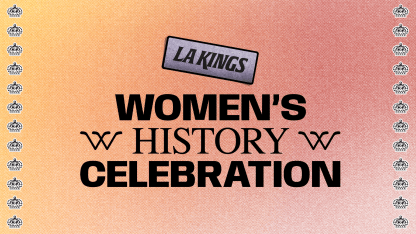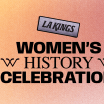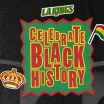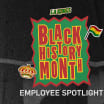As we flip the calendar into the third month of the year, we also enter Women’s History Month.
Established in 1987, March became a 31-day opportunity to look back, reflect on and talk about the many impactful women that helped propel us to where we are today. As an organization, the LA Kings want to recognize Women’s History Month and shine a light on the many women that played integral roles in the growth of women’s hockey, including two female pillars within our own hockey operations team.
While the attention around women’s hockey right now is at an all-time high and seemingly on a track for great success, it hasn’t always been that way. It took many years and attempts for women to be accepted into hockey, not just having their own teams and leagues, but to able to play in general.
Background
According to the International Ice Hockey Federation, women and hockey dates back to the late 1800’s. It was then that Lord Stanley of Preston, the Governor General of Canada the donor of what is now the Stanley Cup, arrived in Canada from the United Kingdom with his wife, Lady Isobel, and their four children. The family quickly fell in love with the sport of hockey. 1890 came around and it was then that his daughter is believed to be the first woman ever photographed playing the game; opening up the possibility for women of all ages to see that the game can be for both men and women.
Many female pioneers followed in the ensuing years, such as Marion Foster, who helped create the first women’s club team at Queen’s University Kingston in Ontario, Canada in 1892. Overcoming adversity due to a lack of support, their team name was the “Love Me Littles” and through persistence and passion, Foster and her team helped create the first ever Canadian university level program.
Starting to flourish, the game of hockey for women was growing in Canada, all across Quebec and Ontario, in the 1920’s. But just as the sport of hockey was solidifying for women, World War II put just about everything on hold, setting women’s hockey backwards for 20+ years.
Due to a lack of support and funding, it was a struggle for women to establish a league of their own. Things finally took a turn for the better in 1966 when Brown University created the first ever women’s hockey team in the United States called the Pembroke Pandas. Brown University’s bold endeavor, which was controversial at the time, paved the way for what we now know as women’s college hockey. Other universities joined in the early 1970’s and the sport of hockey among women began to get its footing once again.
Manon The Trailblazer
Commonly facing adversity and a lack of opportunity because of the limited and almost non-existent options at the youth level, women were often rejected or had to go to great lengths to work their way into the sport.
Insert women’s hockey legend and the LA Kings’ own Manon Rhéaume. Most commonly known for being the first woman to compete in an NHL game, Rhéaume faced multiple obstacles at a young age and if it weren’t for her love of the game and the constant pursuit to prove people wrong, women’s hockey may not look the same as it stands today.
“In Quebec, hockey is huge, it's like a religion there, but when I was young, they had no girls playing at all, not even on the boys’ team or anything,” she recalled. “I had two brothers who played hockey and my dad was a coach. He used to make a nice outdoor ice rink at our house and my brothers, and I would go out and play, nut every time I wanted to play with them, they would dress me up as a goalie and then shoot pucks at me. It was great because I was with them and playing hockey with them, but not at the rink because no girls were playing at the rink.”
Loving the game but unable to join a team, a young Rhéaume didn’t know what her future in hockey would be. Until one night at the dinner table alongside her two brothers and parents in Beauport, Quebec City.
“One night, my dad was at the dinner table and he was talking about on my brothers’ team and how none of the boys wanted to be goalie and they had a tournament coming up. Nobody showed interest to play goalie and he was talking to my mom about how he didn’t know who to pick, and how someone's going to be disappointed. I looked at my dad the age of five and said, ‘Why not me?’ and that's how I got started.”
Her dad was on board and one week out from her tryout and debut, Rhéaume and her father practiced in their basement for hours on end every night.
“When it came time for that first practice, we got to the rink and my dad had to put a helmet on me before I walked into the rink, because he wanted to make sure that nobody knew I was a girl,” she recalled. “I did well and everybody was excited that they had a goalie so none of the boys would have to play goalie and then it's not until after the first practice that people realized that I was a girls but at that point, it was too late for them to complain because they were all excited during practice.”
Unbeknownst to her at the time, Rhéaume’s father dealt with a lot of pushback for having his daughter compete with boys because “she was taking the spot of a boy away.”
In turn, as Rhéaume continued to prove herself on the ice, she would often have to miss games and tournaments because a boy wanted to play goalie. Commonly being denied the net in her youth years to lesser talented boys, Rhéaume didn’t give up. It only fueled the fire, helping her put in the extra work to clearly be the top goalie among her peers, boys included.
“After I started having success, one of the dads would say that his son wanted to play goalie. Because I was having success, it was almost like everybody wants to play goalie. My dad would say to me ‘okay Manon, we’ll put them in net, and I would get to play goalie the following game.’ He would put the boys in net, and they’d lose by a big score. After that, all of the parents were like, ‘Oh, we want to have her back in net. So, I had to earn the respect of every team that I played on growing up because it had my whole youth career.”
Fast forward to Rhéaume’s major junior career and at the age of 20, an opportunity arose to play with the boys as the backup.
Up 5-1 in a game, her team caught up the four-goal lead and in came Rhéaume to stop the puck and change up the momentum. She played well but couldn’t finish the game due to a puck to the helmet cutting her and needing seven stitches, but the cliché that every athlete has heard, “you never know who’s watching” absolutely came to fruition.
Watching the game was a scout for the Tampa Bay Lightning, who went back to management and showed hockey great Phil Esposito, the then President and General Manager of the Lightning her film. He liked what he saw and later that summer at the 1992 NHL Draft in Montreal where Rhéaume had by that time started interning for RDS (the TSN or ESPN equivalent of Quebec) was told Esposito wanted to talk to her.
She recalled the conversation where Esposito invited here to participate in their training camp and that she didn’t believe he was serious at first. Then the letter arrived which showed just how serious it was.
“I remember at that time thinking to myself, they’re just inviting me because you're a girl and all that stuff, but I told myself, you know what, so many times people said no to me because I was a girl. I said it this time, it gives me the opportunity to try out at the highest level of hockey. At the end of the day, it doesn't matter why I'm invited. I'm going to have to prove what I can do on the ice, like it's on me to do what I can do there. I went for it and I went to camp.”
Month later on September 23rd, 1992 Rhéaume took the ice with the Tampa Bay Lightning against the St. Louis Blues and made history as the first woman to compete in an NHL game.
Following her playing career, Rhéaume has dedicated much of her time to growing the women’s game at the youth level. Coaching and building up youth programs across Canada and the United States has had an impact on thousands of women hockey players. Move to 2003, and Rhéaume found herself coaching a U12 elite girls select team in Quebec……forming a connection that would be reunited some 20 years later.
Blake Breaks Barriers
One of Rheaume’s players was now Kings scout and inclusion specialist Blake Bolden.
Bolden, one of women’s hockey’s most influential people, crossed paths Rhéaume at the young age of 12 in route to a groundbreaking and barrier shattering career. Born in Euclid, Ohio, just outside of Cleveland, Bolden too grew up in a world without competitive women’s hockey at her age.
“I feel like women’s hockey didn't really hit the scene for me until I was probably 12 years old, when I was playing on the Ohio Flames as a 12-year-old on the 19U team. There was only boy’s hockey at a high level. Growing up in Cleveland, Ohio. I had to play for the Cleveland Barron's AAA boys’ team… There wasn't a lot, which is why I had to leave and go to Lake Placid, New York, and play at a boarding school so I can get recruited to play college hockey.”
Not only finding herself not playing against her own gender, Bolden also faced the reality that she was almost always the only person of color playing hockey.
“When I was playing AAA boys hockey as you can imagine, I was the only person of color and most of the time the only girl, and I looked around at my peers and their parents and I didn't see a lot of familiar faces. It was a lonely feeling.”
Despite some of the mental battles that Bolden had to face that others did not, she persevered, kept her focus on her passion and earned a Division 1 scholarship to Boston College. Even come 2009, when Bolden attended school as a freshman, women still hadn’t earned the respect that they deserved among the athletic community.
“I remember playing collegiate hockey at Conte Forum and probably having 10 people in the stands, and all of those 10 people were moms, dads, friends of our team and whatnot,” she recalled. “When I was playing at Boston College, we were getting hand-me-downs. We were a Reebok sponsored program at the time and we were getting hand-me-downs from the football team. So, I had like a size XL hoodie and was walking around campus around the Boston College campus in those clothes. And that's your favorite part of being an athlete, is getting the swag and being able to represent the team you're on. That is a part of your pride and I remember getting these hand-me-downs being like ‘wow, okay, this is what we get?’”
Unsatisfied with the state of women’s hockey, Bolden pushed for more and represented more than just herself. Elite in college, Bolden played for what could be in there future and captained her BC team in her senior season.
“Now the girls get fancy Peter Pan buses and the growth has been crazy. You want to always remember where you came from and I definitely feel like I've been a part of supporting the growth in women's hockey, especially at BC and definitely in the professional game.
Enter the 2013-14 hockey season, and Bolden made women’s hockey history becoming the first first woman of color to play the game professional when she stepped on the ice for the Boston Blades of the CWHL.
What’s Ahead
Both Rhéaume and Bolden have been vital players in the growth of women’s hockey.
The hard work and constant battling through adversity was done for the love of the game and has helped set the stage for what women’s hockey has to offer in the present day. Figures like Rhéaume and Bolden figuratively walked so the stars of today could run.
Fast forward to present day and on New Year’s Day, 2024, the PWHL debuted. Comprised of six teams based in Montreal, Toronto, New York, Boston, Ottawa and Minneapolis-St. Paul, the league has been a smashing success in its early stages. In their first week of gameplay, the support set a professional women’s hockey attendance record. Taking place at the Xcel Energy Center in St. Paul, Minnesota, 13,316 fans attended the home opener in the Minnesota versus Montreal game. Just over a month later, history was made again. This time in Toronto, the Battle on Bay Street at Scotiabamk Arena saw Toronto and Montreal face off in front of the 19,285 fans making it the most attended women’s hockey game in history. The inaugural continues to thrive as the level of play and depth of the sport is at an all-time high. The PWHL season is set to go through June 2024.
As to those who could one day be playing in the PWHL, pillars like Rhéaume and Bolden are playing integral roles locally. Both are substantial pieces in the LA Lions women’s youth program based at Toyota Sports Performance Center.
As Bolden put it, “first and foremost, the growth of our LA Lions Girls is great. We've really put an emphasis on wanting to develop that program. Now that we have Manon Rhéaume, who is legitimately a legend herself in developing women's programs - she developed Little Caesars in the Detroit area from the ground up and turned it into a super successful program - to now have her on our roster is amazing. Getting to work with her and piggyback off of each other's ideas and be a really good role model for the young girls who are wanting to play travel AAA hockey, is an amazing opportunity.”
With two of the most important first in the history of women’s hockey, Rhéaume being the first woman to play in the NHL and Bolden being the first black woman to play professional women's hockey, the two women have everything you could want in the experience and knowledge categories.



















